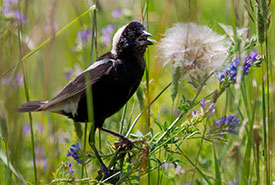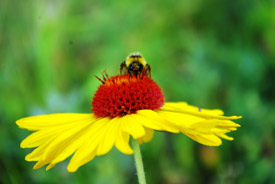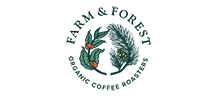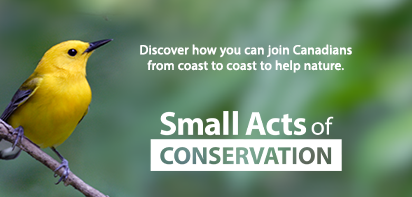Landscaping for biodiversity... and apples

Floral strip (Photo by NCC)
The Covey Hill region is exceptionally biodiverse, and it is home to one of the last large forests in the Montérégie region. The peat bog at the top of the hill plays an important role in the region's water circulation.
Several species of endangered salamanders, including Quebec’s only occurrence of the Allegheny mountain dusky salamander, are found here. These amphibians are particularly sensitive to water quality, as they have no lungs and breathe through their skin. They need cool, unpolluted, moist habitat to survive. As a result, it's vital to ensure that their habitat is protected from disturbance by human activities.
In addition to salamanders, Covey Hill is home to several other at-risk species, such as and eastern meadowlark, two bird species associated with rural environments.

Bobolink, Prairie Smoke Nature Reserve, Carden Alvar, ON (Photo by NCC)
The Nature Conservancy of Canada (NCC) called on Covey Hill apple growers to install biodiversity-friendly features in their orchards. What if, by redesigning their orchards to encourage greater biodiversity, they managed to reduce their impact on watercourses, and, as a result, on stream salamanders?
And what if, with these same facilities, they could improve the productivity and resilience of their orchards?
That's what NCC is proposing with these two documents:
- A tool box featuring options for agri-environmental practices to be implemented in their orchards. Created in collaboration with the Ministère de l'Agriculture, des Pêcheries et de l'Alimentation (MAPAQ) and agronomists, the tool box proposes windbreaks, flower islands, riparian buffer strips, bird nesting boxes and bat dormitories.
- A promotional tool (Biodiversité aux champs) recognizing the actions taken by apple growers to promote biodiversity, and encouraging other growers to adopt better practices.

Bee on flower (Photo by NCC)
The proposed improvements each have a specific purpose: attracting insects that predate and parasitize pests (flower island), reducing pesticide drift in the wind (windbreak hedge) or filtering contaminants before they enter watercourses (riparian buffer strip).
Together, however, these developments share a common goal: to improve the resilience of the natural environment in the face of disturbance and climate change.
NCC's ultimate goal is to continue our efforts by implementing conservation measures that benefit biodiversity first, but also agriculture. NCC is able to offer customized conservation tools to apple producers who wish to protect the natural environment on their land.
Thank you to our partners:


Gouvernement du Québec

Thank you to participating orchards:
- Les Vergers du Château Albert;
- Les Vergers Leahy;
- Les Vergers Écologiques Philion;
- Les Vergers Pomibec inc.
We acknowledge the support of:
- MAPAQ;
- Agronomists Lauréline Boyer, Andréa Schroeder and Vicky Filion;
- Pleine Terre, Gestrie-Sol and Club Producteurs Sud-Ouest (CPSO).




